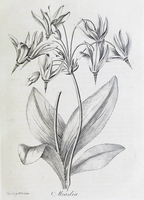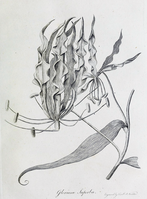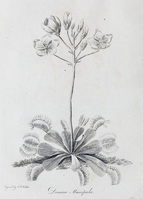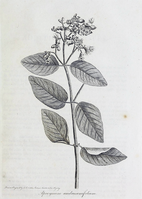The loves of the plants
The loves of the plants („Die Lieben der Pflanzen“) ist der Titel eines 1789 anonym veröffentlichten didaktischen Poems von Erasmus Darwin über Carl von Linnés Sexualsystem der Pflanzen. Es ist der zuerst veröffentlichte zweite Teil seines Werkes The botanic garden. Dessen erster Teil wurde 1792 unter dem Titel The economy of vegetation veröffentlicht. The loves of the plants wurde ins Französische (1800) und ins Italienische (1805) übersetzt.
Werk
[Bearbeiten | Quelltext bearbeiten]Das Werk im Quartformat trägt den vollständigen Titel The botanic garden. Part II. containing The loves of the plants. A poem. With philosophical notes. Es wurde in Lichfield, Darwins ehemaligen Wohnsitz, von John Jackson (ca. 1750–ca. 1815) gedruckt und vom Londoner Verleger Joseph Johnson (1738–1809) vertrieben. Die 1. Auflage wurde im April 1789 veröffentlicht. Die vier Canti (Gesänge) umfassen 1756 Verszeilen auf 184 Seiten.[1] Die 1. Auflage enthält sieben ganzseitige Kupferstiche. Sie stammen von E. Stringer, einem Künstler aus Lichfield, sowie von Frederick Polydore Nodder.
Das im Aquatinta-Verfahren hergestellte Frontispiz zeigt in einem oben mit Blumen verzierten ovalen Rahmen Flora und Amor in einem Garten. Die mit Blumen geschmückte Flora hält Amors Pfeil und Bogen. Amor ist nur mit einer Gärtnerschürze bekleidet und schultert einen Spaten und Rechen. Zu seinen Füßen befindet sich ein Blumenkorb. Das Frontispiz wurde von Emma Crewe (1741–1795 oder später) entworfen und von Samuel Alken (1756–1815) graviert.[2]
Beide Teile von The botanic garden wurden anonym veröffentlicht. Offiziell bestätigte Darwin seine Urheberschaft erst 1794. Auf dem Titelblatt des ersten Bandes seiner Zoonomia bezeichnete er sich selbst als „Author of The Botanic Garden“.
Gliederung
[Bearbeiten | Quelltext bearbeiten]- Preface (Vorwort)
- Proem (Vorrede)
- Canto I. (Gesang I.)
- Interlude (Zwischenspiel)
- Canto II. (Gesang II.)
- Interlude II. (Zwischenspiel II.)
- Canto III. (Gesang III.)
- Interlude III. (Zwischenspiel III.)
- Canto IV. (Gesang IV.)
- Additional notes
- Catalogue of the Poetic Exhibition.
- Contents of the Notes.
- Index of the Names of the Plants.
Abbildungen
[Bearbeiten | Quelltext bearbeiten]- E. Stringer
- Darstellung der Merkmale der 24 Klassen
- Abgebildete Pflanzen
-
Ruhmeskrone (Gloriosa superba)
-
Venusfliegenfalle (Dionaea muscipula)
-
Gewöhnliche Wasserschraube (Vallisneria spiralis)
Liste der Gattungen
[Bearbeiten | Quelltext bearbeiten]In The loves of the plants wird auf folgende Pflanzengattungen verwiesen:[3][4]
| Nr. | Gattung | 1. Auflage (Canto:Vers) | 2. Auflage (Canto:Vers) | 3. Auflage (Canto:Vers) | Linnésche Klasse - Ordnung | Seite in Species Plantarum (1753) |
|---|---|---|---|---|---|---|
| 1 | Blumenrohr (Canna) | 1:39 | 1:39 | 1:39 | I. Monandria - Monogynia | 1 |
| 2 | Wassersterne (Callitriche) | 1:45 | 1:45 | 1:45 | XXI. Monoecia - Digynia | 969 |
| 3 | Collinsonia | 1:51 | 1:51 | 1:51 | II. Diandria - Monogynia | 28 |
| 4 | Ginster (Genista) | 1:57 | 1:57 | 1:57 | XVII. Diadelphia - Hexandria | 709 |
| 5 | Melissen (Melissa) | 1:60 | 1:60 | 1:60 | XIV. Didynamia - Gymnospermia | 592 |
| 6 | Götterblumen (Dodecatheon) | 1:61 | 1:61 | 1:61 | V. Pentandria - Monogynia | 144 |
| 7 | Curcuma | 1:65 | 1:65 | 1:65 | I. Monandria - Monogynia | 2 |
| 8 | Stockrosen (Alcea) | 1:69 | 1:69 | 1:69 | XVI. Monadelphia - Polyandria | 687 |
| 9 | Schwertlilien (Iris) | 1:71 | 1:71 | 1:71 | III. Triandria - Monogynia | 38 |
| 10 | Zypressen (Cupressus) | 1:73 | 1:73 | 1:73 | XXI. Monoecia - Monandria | 1002 |
| 11 | Rutensträucher (Osyris) | 1:75 | 1:75 | 1:75 | XXII. Dioecia - Triandria | 1022 |
| 12 | Wegeriche (Plantago) | 1:77 | 1:77 | 1:77 | IV. Tetrandria - Monandria | 112 |
| 13 | Ruchgräser (Anthoxanthum) | 1:83 | 1:83 | 1:83 | II. Diandria - Digynia | 28 |
| 14 | Königsfarne (Osmunda) | 1:93 | 1:93 | 1:93 | XXIV. Cryptogamia - Filices | 1063 |
| 15 | Knorpellattiche (Chondrilla) | 1:97 | 1:97 | 1:97 | XIX. Syngenesia - Polygamia aequalis | 796 |
| 16 | Pechnelken (Lychnis) | 1:108 | 1:108 | 1:108 | X. Decandria - Pentagynia | 436 |
| 17 | Gloriosa | 1:119 | 1:119 | 1:119 | VI. Hexandria - Monogynia | 305 |
| 18 | Leimkräuter (Silene) | 1:139 | 1:139 | 1:139 | X. Decandria - Trigynia | 416 |
| 19 | Amaryllis | 1:152 | 1:152 | VI. Hexandria - Monogynia | 292 | |
| 20 | Stechpalmen (Ilex) | 1:143 | 1:161 | 1:161 | IV. Tetrandria - Tetragynia | 125 |
| 21 | Kleinhovia | 1:157 | 1:183 | 1:183 | XX. Gynandria - Decandria | |
| 22 | Tulpen (Tulipa) | 1:171 | 1:205 | 1:205 | VI. Hexandria - Monogynia | 305 |
| 23 | Zeitlose (Colchicum) | 1:184 | 1:214 | 1:214 | VI. Hexandria - Trigynia | 341 |
| 24 | Sonnenblumen (Helianthus) | 1:191 | 1:223 | 1:223 | XIX. Syngenesia - Polygamia superflua | 904 |
| 25 | Sonnentau (Drosera) | 1:199 | 1:231 | 1:231 | V. Pentandria - Pentagynia | 281 |
| 26 | Heckenkirschen (Lonicera) | 1:211 | 1:243 | 1:243 | V. Pentandria - Monogynia | 173 |
| 27 | Felsenblümchen (Draba) | 1:220 | 1:252 | 1:252 | XV. Tetradynamia - Siliculosa | 642 |
| 28 | Misteln (Viscum) | 1:226 | 1:260 | 1:260 | XXII. Dioecia - Tetrandia | 1023 |
| 29 | Seegräser (Zostera) | 1:232 | 1:266 | 1:266 | XX. Gynandria - Polyandria | 968 |
| 30 | Tüpfelfarne (Polypodium) | 1:250 | 1:284 | 1:284 | XXIV. Cryptogamia - Filices | 1082 |
| 31 | Mimosen (Mimosa) | 1:247 | 1:301 | 1:301 | XIII. Polyandria - Monogynia | 516 |
| 32 | Windröschen (Anemone) | 1:264 | 1:318 | 1:318 | XIII. Polyandria - Polygynia | 538 |
| 33 | Flechten („Lichen“) | 1:295 | 1:349 | 1:349 | XXIV. Cryptogamia - Algae | 1140 |
| 34 | Karden (Dipsacus) | 1:313 | 1:367 | 1:367 | IV. Tetrandria - Monogynia | 97 |
| 35 | Färberröten (Rubia) | 1:321 | 1:375 | 1:375 | IV. Tetrandria - Monogynia | 109 |
| 36 | Vallisneria | 1:341 | 1:395 | 1:395 | XXII. Dioecia - Didandria | 1015 |
| 37 | Ulva | 1:353 | 1:407 | 1:407 | XXIV. Cryptogamia - Algae | 1163 |
| 38 | Zitterlinge (Tremella) | 1:373 | 1:427 | 1:427 | XXIV. Cryptogamia - Algae | 1157 |
| 39 | Eberwurzen (Carlina) | 2:7 | 2:7 | 2:7 | XIX. Syngenesia - Polygamia aequalis | 828 |
| 40 | Lein (Linum) | 2:67 | 2:67 | 2:67 | V. Pentandria - Pentagynia | 277 |
| 41 | Baumwolle (Gossypium) | 2:87 | 2:87 | 2:87 | XVI. Monadelphia - Polyandria | 693 |
| 42 | Zypergräser (Cyperus) | 2:105 | 2:105 | 2:105 | III. Triandria - Monogynia | 44 |
| 43 | Lapsana | 2:165 | 2:165 | 2:165 | XIX. Syngenesia - Polygamia aequalis | 811 |
| 44 | Seerosen (Nymphaea) | 2:165 | 2:165 | 2:165 | XIII. Polyandria - Monogynia | 510 |
| 45 | Ringelblumen (Calendula) | 2:166 | 2:166 | 2:166 | XIX. Syngenesia - Polygamia necessaria | 921 |
| 46 | Nieswurz (Helleborus) | 2:199 | 2:201 | 2:201 | XIII. Polyandria - Polygynia | 557 |
| 47 | Mondsamen (Menispermum) | 2:227 | 2:229 | 2:229 | VI. Hexandria - Trigynia | 340 |
| 48 | Mohn (Papaver) | 2:268 | 2:270 | 2:270 | XIII. Polyandria - Monogynia | 506 |
| 49 | Zistrosen (Cistus) | 2:301 | 2:305 | 2:305 | XIII. Polyandria - Monogynia | 523 |
| 50 | Chinarindenbäume (Cinchona) | 2:345 | 2:349 | 2:349 | V. Pentandria - Monogynia | 172 |
| 51 | Fingerhüte (Digitalis) | 2:421 | 2:425 | 2:425 | XIV. Didynamia - Angiospermia | 621 |
| 52 | Hexenkräuter (Circaea) | 3:7 | 3:7 | 3:7 | II. Diandria - Monogynia | 9 |
| 53 | Prunus | 3:40 | 3:40 | 3:40 | XII. Icosandria - Monogynia | 473 |
| 54 | Feigen (Ficus) | 3:80 | 3:80 | 3:80 | XXIII. Polygamia - Polyoecia | 1059 |
| 55 | Springkräuter (Impatiens) | 3:131 | 3:131 | 3131 | XIX. Syngenesia - Monogamia | 937 |
| 56 | Diptam (Dictamnus) | 3:184 | 3:184 | 3:184 | X. Decandria - Monogynia | 383 |
| 57 | Hippomane | 3:188 | 3:188 | 3:188 | XXI. Monoecia - Monadelphia | 1191 |
| 58 | Brennnesseln (Urtica) | 3:191 | 3:191 | 3:191 | XXI. Monoecia - Triandria | 983 |
| 59 | Lobelien (Lobelia) | 3:193 | 3:193 | 3:193 | XIX. Syngenesia - Monogamia | 929 |
| 60 | Seide (Cuscuta) | 3:329 | 3:327 | 3:329 | IV. Tetrandria - Digynia | 124 |
| 61 | Knabenkräuter (Orchis) | 3:259 | 3:259 | XX. Gynandria - Diandria | 939 | |
| 62 | Weinreben (Vitis) | 3:287 | 3:355 | 3:357 | V. Pentandria - Monogynia | 202 |
| 63 | Alpenveilchen (Cyclamen) | 3:311 | 3:379 | 3:381 | V. Pentandria - Monogynia | 145 |
| 64 | Kassien (Cassia) | 3:345 | 3:413 | 3:415 | X. Decandria - Monogynia | 376 |
| 65 | Cereus | 4:15 | 4:15 | 4:15 | XII. Icosandria - Monogynia | |
| 66 | Kapuzinerkressen (Tropaeolum) | 4:45 | 4:45 | 4:45 | VIII. Octandria - Monogynia | 345 |
| 67 | Hafer (Avena) | 4:73 | 4:73 | 4:73 | III. Triandria - Digynia | 79 |
| 68 | Schneeglöckchen (Galanthus) | 4:103 | 4:133 | 4:137 | VI. Hexandria - Monogynia | 288 |
| 69 | Gänseblümchen (Bellis) | 4:114 | 4:144 | 4:148 | XIX. Syngenesia - Polygamia superflua | 886 |
| 70 | Hanf (Cannabis) | 4:111 | 4:115 | XXII. Dioecia - Tetrandia | 1027 | |
| 71 | Fucus | 4:161 | 4:191 | 4:195 | XXIV. Cryptogamia - Algae | 1158 |
| 72 | Trapa | 4:170 | 4:200 | 4:204 | IV. Tetrandria - Monogynia | 120 |
| 73 | Basilikum (Ocimum) | 4:221 | 4:225 | XIV. Didynamia - Gymnospermia | 597 | |
| 74 | Aronstab (Arum) | 4:187 | 4:281 | 4:285 | XX. Gynandria - Polyandria | 964 |
| 75 | Nelken (Dianthus) | 4:207 | 4:299 | 4:304 | X. Decandria - Digynia | 409 |
| 76 | Süßklee (Hedysarum) | 4:237 | 4:331 | 4:335 | XVII. Diadelphia - Decandria | 745 |
| 77 | Corallina | 4:259 | 4:353 | 4:357 | XXIV. Cryptogamia - Algae | |
| 78 | Stäublinge (Lycoperdon) | 4:298 | 4:392 | 4:396 | XXIV. Cryptogamia - Fungi | 1183 |
| 79 | Byssus | 4:357 | 4:437 | 4:441 | XXIV. Cryptogamia - Algae | 1168 |
| 80 | Adonisröschen (Adonis) | 4:388 | 4:468 | 4:468 | XIII. Polyandria - Polygynia | 547 |
Auflagen
[Bearbeiten | Quelltext bearbeiten]Die 2. Auflage erschien im Januar 1790.[5] Durch das Hinzufügen der Abschnitte Catalogue of the Poetic Exhibition, Contents of the Notes und an Index of the Names of the Plants sowie die Überarbeitung der Fußnote und Endnoten wuchs der Umfang um 18 Seiten.[6] Neu waren Verse über die Gattungen Cannabis, Orchis und Amaryllis. Außerdem ersetzte Darwin die von E. Stringer angefertigten Diagramme der Linnéschen Klassen sowie die Abbildung von der Art Dodecatheon meadia durch von Nodder neu gestochene.[7] Mit der 3. Auflage wurden Druckfehler und Fehlnummerierungen korrigiert sowie der Inhalt erweitert. Darwin fügte allein dem Canto IV. etwa 100 Verszeilen, insbesondere über Cannabis, hinzu. Der Umfang stieg von ursprünglich 1746 Zeilen auf 1938 Verszeilen.[8] Die erste vollständige Auflage von The botanic garden bestand aus der 1. Auflage des auf 1791 datierten, aber erst im Juni 1792 veröffentlichten, ersten Teils und der 1791 veröffentlichten 3. Auflage des zweiten Teils.[9]
Die erste gemeinsame Auflage beider Teile war die 4. Auflage von 1794. Nach dem Erscheinen des ersten Teils wurde ein zusätzliches Titelblatt gedruckt, das es ermöglichte beide Teile zu vereinen: „The botanic garden; A poem, in two parts. Part I. Containing The economy of vegetation. Part II. The loves of the plants. With philosophical notes. London, Printed for J. Johnson, St. Paul’s Church-Yard 1795. Entered at Stationers’ Hall“.[10] Mit der dritten Auflage des ersten Teils im Jahr 1795 erschien ein geändertes gemeinsames Titelblatt „The third edition. London: Printed for J. Johnson, St. Paul’s Church-Yard 1795. Entered at Stationers’ Hall“. Ab 1799 erschienen die Auflagen im Oktavformat.
Originalausgaben
Vom zweiten Teil von The botanic garden gibt es folgenden Auflagen:[11]
- 1. Auflage. J. Johnson, London 1789 (Digitalisat).
- 2. [überarbeitete] Auflage. J. Johnson, London 1790 (Volltext).
- 3. Auflage. J. Johnson, London 1791 (Digitalisat).
- 4. Auflage. J. Johnson, London 1794 (Digitalisat) – oft mit 3. Auflage von Teil 1 von 1795.
- 5. Auflage. J. Johnson, London 1799 (Digitalisat) – erste gemeinsame Ausgabe beider Teile, Oktavformat.
- 6. Auflage. J. Johnson, London 1806 (Digitalisat) Band 2 von The poetical works of Erasmus Darwin
- 7. Auflage. Jones & Company, London 1824 (Digitalisat).
Irische Ausgaben
- James Moore, Dublin 1790.
- James Moore, Dublin 1796.
Amerikanische Ausgaben
- Thomas & James Sword, New York 1798.
- Thomas & James Sword, New York 1807 (Digitalisat).
Übersetzungen
- Les Amours des plantes, poème en quatre chants; suivi de notes et de dialogues sur la poésie. Paris 1800 (Digitalisat) – ins Französische übersetzt durch Joseph Philippe François Deleuze.
- Gli amori delle piante. Poema con note filosofiche. Mailand 1805 (Digitalisat) – ins Italienische übersetzt durch Giovanni Gherardini (1778–1861).
- Neapel 1817 (Digitalisat).
- 2. Auflage. Mailand 1818 (Digitalisat).
- Neapel 1817 (Digitalisat).
Besprechungen
[Bearbeiten | Quelltext bearbeiten]- The Analytical Review, Or History of Literature, Domestic and Foreign, on an Enlarged Plan. Band 4, Mai 1789, S. 29–37 (online)
- The English Review; Or, An Abstract of English and Foreign Literature. For the Year M.DCC.LXXXIX. Band 14, Juli 1789, S. 1–8, S. 128–132 (online).
- M. R.: [Besprechung von The Botanic Garden.] In: Intelligenzblatt der Allgemeinen Literatur-Zeitung. Band 96, 8. August 1789, S. 798 (online).
- [Besprechung von The Botanic Garden, 3. Auflage.] In: Göttingische Anzeigen von gelehrten Sachen. Band 114, 16. Juli 1796, S. 1129–1144 (online).
Literatur
[Bearbeiten | Quelltext bearbeiten]- Janet Browne: Botany for gentlemen: Erasmus Darwin and “The loves of the plants”. In: Isis. Band 80, Nr. 4, 1989, S. 593–621 (doi:10.1086/355166).
- Tristanne Connolly: Flowery porn: form and desire in Erasmus Darwin’s The Loves of the Plants. In: Literature Compass. Band 13, Nr. 10, 2016, S. 604–616 (doi:10.1111/lic3.12347).
- C. A. Vaughn Cross: Blurring Plant and Human Boundaries: Erasmus Darwin’s The Loves of the Plants. In: Natalie Roxburgh, Jennifer S. Henke (Hrsg.): Psychopharmacology in British Literature and Culture, 1780–1900. 2020, S. 93–115 (doi:10.1007/978-3-030-53598-8_5).
- Linda Dietrick: Vegetable Genius and the Loves of the Plants: Botany in German Poetry Around 1800. In: John L. Plews, Diana Spokiene (Hrsg.): Translation and Translating in German Studies. A Festschrift for Raleigh Whitinger. Wilfrid Laurier University Press, 2016, ISBN 978-1-77112-228-3, S. 45–62.
- Asia Haut: Reading Flora: Erasmus Darwin’s The Botanic Garden, Henry Fuseli’s Illustrations, and Various Literary Responses. In: Word and Image. Band 20, Nr. 4, 2004, S. 240–256 (doi:10.1080/02666286.2004.10444021).
- Desmond King-Hele: A concordance to Erasmus Darwin’s poem ‘The Botanic Garden’. Wellcome Institute for the History of Medicine, London 1994, ISBN 1-869835-50-6.
- Allison Dushane, Adam Komisaruk (Hrsg.): The Botanic Garden by Erasmus Darwin. 2 Bände, Routledge, New York 2017, ISBN 978-1-84893-565-5.
- Julia List: Sometimes a Stamen is Only a Stamen: Sexuality, Women and Darwin’s Loves of the Plants. In: Nineteenth-Century Contexts. Band 32, Nr. 3, 2010, S. 199–218 (doi:10.1080/08905495.2010.511763).
- Dahlia Porter: Scientific Analogy and Literary Taxonomy in Darwin’s Loves of the Plants. In: European Romantic Review. Band 18, Nr. 2, 2007, S. 213–221 (doi:10.1080/10509580701297950).
- Dahlia Porter: Epistemic images and vital nature: Darwin’s Botanic Garden as image text book. In: European Romantic Review. Band 29, Nr. 3, 2018, S. 295–308 (doi:10.1080/10509585.2018.1465717, PDF).
- John Ryan: A Poetry of Science or a Science of Poetry? The Speculative Method of Erasmus Darwin (1731–1802). In: The International Journal of Literary Humanities. Band 10, Nr. 1, 2013, S. 45–57 (doi:10.18848/2327-7912/CGP/v10i01/43927, PDF).
- Ann Shteir: “She comes! – the GODDESS!”: Narrating Nature in Erasmus Darwin’s The Botanic Garden. In: Christine Lehleiter (Hrsg.): Fact and Fiction. Literary and Scientific Cultures in Germany and Britain. University of Toronto Press, Toronto / Buffalo / London 2016, ISBN 978-1-4426-4598-1, S. 73–96.
- Fredrika J. Teute: The Loves of the Plants; or, the Cross-Fertilization of Science and Desire at the End of the Eighteenth Century. In: Huntington Library Quarterly. Band 63, Nr. 3, S. 319–345 (doi:10.2307/3817747).
Einzelnachweise
[Bearbeiten | Quelltext bearbeiten]- ↑ Desmond King-Hele: Erasmus Darwin. A Life of Unequalled Achievement. London 1999, ISBN 1-900357-08-9, S. 232–233.
- ↑ Flora at Play with Cupid in der Sammlung des British Museum.
- ↑ Taxonomic Table to The Loves of the Plants. In: Allison Dushane, Adam Komisaruk (Hrsg.): The Botanic Garden by Erasmus Darwin. Band 2, Routledge, New York 2017, ISBN 978-1-84893-565-5, S. Allison Dushane, Adam Komisaruk (Hrsg.): The Botanic Garden by Erasmus Darwin. 2 Bände, Routledge, New York 2017, ISBN 978-1-84893-565-5, S, Allison Dushane, Adam Komisaruk (Hrsg.): The Botanic Garden by Erasmus Darwin. 2 Bände, Routledge, New York 2017, ISBN 978-1-84893-565-5, S. Allison Dushane, Adam Komisaruk (Hrsg.): The Botanic Garden by Erasmus Darwin. 2 Bände, Routledge, New York 2017, ISBN 978-1-84893-565-5, S. 173–194.
- ↑ Janet Browne: Botany for gentlemen: Erasmus Darwin and “The loves of the plants”. In: Isis. Band 80, Nr. 4, 1989, S. 609–610.
- ↑ Desmond King-Hele: Erasmus Darwin. A Life of Unequalled Achievement. London 1999, ISBN 1-900357-08-9, S. 249.
- ↑ Dahlia Porter: Epistemic images and vital nature: Darwin’s Botanic Garden as image text book. In: European Romantic Review. Band 29, Nr. 3, 2018, S. 3.
- ↑ Dahlia Porter: Epistemic images and vital nature: Darwin’s Botanic Garden as image text book. In: European Romantic Review. Band 29, Nr. 3, 2018, S. 7–8.
- ↑ Desmond King-Hele: Erasmus Darwin. A Life of Unequalled Achievement. London 1999, ISBN 1-900357-08-9, S. 253.
- ↑ Desmond King-Hele: Erasmus Darwin. A Life of Unequalled Achievement. London 1999, ISBN 1-900357-08-9, S. 253.
- ↑ The botanic garden; A poem, in two parts. Part I. Containing The economy of vegetation. Part II. The loves of the plants. With philosophical notes. London, Printed for J. Johnson, St. Paul’s Church-Yard 1795. Entered at Stationers’ Hall.(online).
- ↑ Gerald Eades Bentley, Martin K. Nurmi: A Blake Bibliography: Annotated Lists of Works, Studies, and Blakeana. University of Minnesota Press, Minnesota 1964, ISBN 0-8166-5706-8, S. 106–108.
Weblinks
[Bearbeiten | Quelltext bearbeiten]- Volltext beim Eighteenth-Century Poetry Archive












